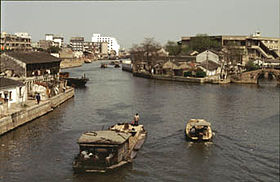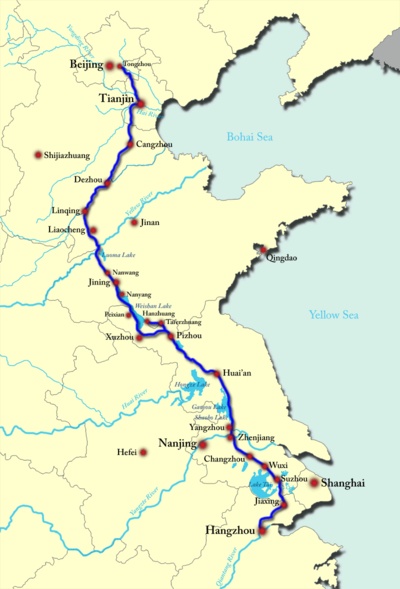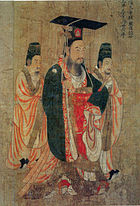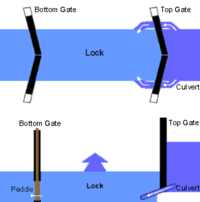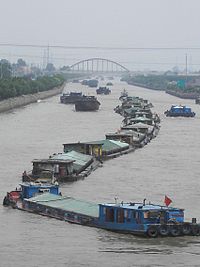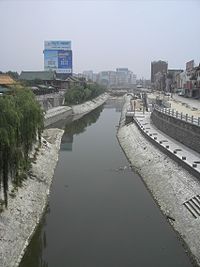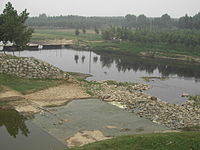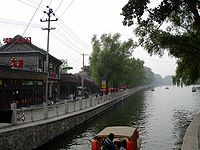
Grand Canal (China)
Background Information
SOS believes education gives a better chance in life to children in the developing world too. Click here for more information on SOS Children.
The Grand Canal of China ( simplified Chinese: 大运河; traditional Chinese: 大運河; pinyin: Dà Yùnhé), also known as the Beijing-Hangzhou Grand Canal ( simplified Chinese: 京杭大运河; traditional Chinese: 京杭大運河; pinyin: Jīng Háng Dà Yùnhé) is the longest ancient canal or artificial river in the world. It passes through the cities of Beijing and Tianjin and the provinces of Hebei, Shandong, Jiangsu and Zhejiang. The oldest parts of the canal date back to the 5th century BC, although the various sections were finally combined into one during the Sui Dynasty (581–618 AD).
The total length of the Grand Canal is roughly 1,770 km (1,114 miles). Its greatest height is reached in the mountains of Shandong, at a summit of roughly 42 m (138 ft); ships traveling in canals of China did not have trouble reaching higher elevations since the 10th century, when the pound lock was invented in Song Dynasty China. The canal's size and grandeur had won for it the admiration of many throughout history, including the Japanese monk Ennin (794–864), the Persian historian Rashid al-Din (1247–1318), and the Korean official Choe Bu (1454–1504).
Historically, the periodic flooding of the adjacent Yellow River threatened the safety and functioning of the Grand Canal. On some occasions—during times of war—the high dykes of the Yellow River were purposefully broken in order to flood advancing enemy troops. Yet this ultimately caused disaster and prolonged economic hardships. Despite temporary periods of desolation and disuse, the Grand Canal fomented an indigenous and growing economic market of China's urban centers throughout the ages since the Sui.
History
Early history
In the late Spring and Autumn Period (722-481 BC), Fuchai, the Duke of Wu (present-day Suzhou), ventured north to conquer the neighbouring state of Qi. He ordered a canal be constructed for trading purposes, as well as a means to ship ample supplies north lest his forces should engage the northern states of Song and Lu. This canal became known as the Han Gou, or 'Han-country Conduit'. Work began in 486 BC south of Yangzhou in Jiangsu, and within three years the Han Gou had connected the Yangtze River to the Huai River by means of existing waterways, lakes and marshes.
The Han Gou is actually known as the second oldest section of the later Grand Canal, since the Hong Gou ('Canal of the Flying Geese', or 'Far-Flung Canal') most likely preceded it. It linked the Yellow River near Kaifeng to the Si and Bian rivers, and became the model for the shape of the Grand Canal in the north. The exact date of the Hong Gou's construction is uncertain; its first known written mention was made by the diplomat Su Qin in 330 BC when discussing state boundaries. The historian Sima Qian (145–90 BC) dated it much earlier than the 4th century BC, attributing it to the work of the mythological Yu the Great; modern scholars now consider it to belong to the 6th century BC.
This Han Gou section of the canal was not only important for private trade, but remained continually important for conducting martial marine campaigns. For example, in the year 280 the naval commander Wang Jun led a victorious campaign against Eastern Wu by facilitating the use of this canal for his passing fleet. By the middle of the sixth century AD, its winding course had been rationalised into a straighter canal, the Shanyang River, which took its name from its terminus on the Huai.
Grand Canal in the Sui Dynasty
The Grand Canal as we see it today was in large part a creation of the Sui Dynasty (581-618), a result of the migration of China’s core economic and agricultural region away from the Yellow River valley and toward what is now Jiangsu and Zhejiang provinces. Its main role throughout its history was the transport of grain to the capital. However, the institution of the Grand Canal by the Sui also obviated the need for the army to become self-sufficient farmers while posted in the northern frontier, as food supplies could now easily be shipped from south to north.
By the year 600, there were major build ups of silt on the bottom of the Hong Gou canal, obstructing river barges whose drafts were too deep for its waters. The chief engineer of the Sui Dynasty, Yuwen Kai, advised the dredging of a new canal that would run parallel to the existing canal, diverging from it at Chenliu ( Yanzhou). The new canal was to pass not Xuzhou, but Suzhou, to avoid connecting with the Si River, and instead make a direct connection with the Huai River just west of Lake Hongze. With the recorded labor of five million men and women under the supervision of Ma Shumou, the first major section of the Grand Canal was completed in the year 605—called the Bian Qu. The Grand Canal was fully completed under the second Sui emperor, from the years 604 to 609, first by linking Luoyang to the Yangzhou (and the Yangzi valley), then expanding it to Hangzhou (south), and to Beijing (north). This allowed the southern area to provide grains to the northern province and to troops. Running alongside and parallel to the canal was an imperial roadway and post offices supporting a courier system. The government also planted an enormous line of trees. The history of the canal's construction is handed down in the book Kaiheji ('Record of the Opening of the Canal').
The earlier dyke-building project in 587 along the Yellow River—overseen by engineer Liang Rui—established canal lock gates which regulated water levels for the canal. Double slipways were also installed in order to haul boats over when the difference in water levels were too great for the flash lock to operate.
Between 604 to 609, Emperor Yang Guang (or Sui Yangdi) of the Sui dynasty ordered a number of canals be dug in a ‘Y’ shape, from Hangzhou in the south to termini in (modern) Beijing and in the capital region along the Yellow River valley. When the canal was completed it linked the river systems of the Qiantang River, the Yangtze River, the Huai River, the Yellow River, the Wei River and the Hai River. Its southern section, running between Hangzhou and the Yangtze, was named the Jiangnan River (the river ‘South of the Yangtze’). The canal’s central portions stretched from Yangzhou to Luoyang: the section between the Yangtze and the Huai continued to be the Shanyang River; the next section connected the Huai to the Yellow and was called the Tongji Channel. The northernmost portion, linking Beijing and Luoyang, was named the Yongji Channel. This portion of the canal was used to transport troops to what is now the North Korean border region during the Goguryeo-Sui Wars (598–614). After the canal's completion in 609, Emperor Yang led a recorded 105 km (65 mile) long naval flotilla of boats from the north down to his southern capital at Yangzhou.
It should be recognized that the Grand Canal at this time was not a continuous, man-made canal but a collection of often non-contiguous artificial cuts and canalised or natural rivers.
Grand Canal from Tang to Yuan
Although the Tang Dynasty (618–907) capital at Chang'an was the most thriving metropolis of China in its day, it was the city of Yangzhou—in close proximity to the Grand Canal—that was the economic hub during the Tang era. Besides being the headquarters for the government salt monopoly and the largest pre-modern industrial production center of the empire, Yangzhou was also the geographical midpoint along the north-south trade axis, and so became the major centre for southern goods shipped north. One of the greatest benefits of the canal system in the Tang Dynasty—and subsequent dynasties—was that it reduced the cost of shipping taxed grain from the Yangtze River Delta to northern China. Minor additions to the canal were made since the Sui to cut down on travel time, but overall no fundamental differences existed between the Sui and Tang Grand Canal.
By the year 735 it was recorded that about 149,685,400 kg (165,000 t) of grain was shipped annually along the canal. The Tang government oversaw canal lock efficiency and built granaries along route in case a flood or other disaster impeded the path of shipment. To ensure smooth travel of grain shipments, the Transport Commissioner Liu Yan (in office from 763–779) had special river barge ships designed and constructed to fit the depths of each section of the entire canal.
After the An Shi Rebellion (755–763), the economy of north China was greatly damaged and never recovered due to wars and to constant floodings of the Yellow River. Such a case occurred in the year 858 when an enormous flood along the Grand Canal inundated thousands of acres of farmland and killed tens of thousands of people in the North China Plain. Such an ill-fated event reduced the legitimacy of a ruling dynasty and those who perceived it as losing the Mandate of Heaven; this was a good reason for dynastic authorities to maintain a smooth and efficient-running canal system.
The city of Kaifeng grew to be a major hub, later becoming the capital of the Song Dynasty (960–1279). Although the Tang and Song dynasty international seaports—the greatest being Guangzhou and Quanzhou, respectively—and the maritime foreign trade brought merchants great fortune, it was the Grand Canal within China that spurred the greatest amount of economic activity and commercial profit. During the Song and earlier periods, barge ships occasionally crashed and wrecked along the Shanyang Yundao section of the Grand Canal while passing the double slipways, and more often than not they were robbed of the tax grain by local bandits. This prompted Qiao Weiyo, an Assistant Commissioner of Transport for Huainan, to invent a double-gate system known as the pound lock in the year 984. This allowed ships to wait within a gated space while the water could be drained to appropriate levels, while the Chinese also built roofed hangers over the space to add further protection for the ships.
Much of the Grand Canal south of the Yellow River was ruined for several years after 1128, when Du Chong decided to break the dykes and dams holding back the waters of the Yellow River in order to decimate the oncoming Jurchen invaders. The Jurchen Jin Dynasty continually battled with the Song in the region between the Huai River and Yellow River; this warfare led to the dilapidation of the canal until the Mongols invaded in the 13th century and began necessary repairs.
During the Mongol Yuan Dynasty (1271–1368), the capital of China was moved to Beijing, eliminating the need for the canal arm flowing west to Kaifeng or Luoyang. A summit section was dug across the foothills of the Shandong massif during the 1280s, shortening the overall length by as much as 700 km (making the total length about 1800 km) and linking Hangzhou and Beijing in a direct north-south waterway for the first time. Just like the Song and Jin era, the canal fell into disuse and dilapidation during the Yuan Dynasty's decline.
Ming Dynasty restoration
The Grand Canal was renovated almost in its entirety between 1411 and 1415 during the Ming Dynasty (1368–1644). A magistrate of Jining, Shandong sent a memorial to the throne of the Yongle Emperor protesting the current inefficient means of transporting 4,000,000 shi (428,000,000 liters) of grain a year by means of transferring it along several different rivers and canals in barge types that went from deep to shallow after the Huai River, and then transferred back onto deep barges once the shipment of grain met with the Yellow River. Chinese engineers built a dam to divert the Wen River to the southwest in order to feed 60% of its water north into the Grand Canal and the other percent heading south. They dug four large reservoirs in Shandong to regulate water levels, which allowed them to avoid pumping water from local sources and tables. Between 1411 and 1415, a total of 165,000 laborers dredged the canal bed in Shandong, built new channels, embankments, and canal locks.
The Yongle Emperor moved the Ming capital from Nanjing to Beijing in 1403. This move deprived Nanjing of its status as chief political centre of China. The reopening of the Grand Canal also benefited Suzhou over Nanjing, since the former was in a better position along the main artery of the Grand Canal, hence it became Ming China's greatest economic centre. The only other viable contender with Suzhou in the Jiangnan region was Hangzhou, but it was located 200 km (124 miles) further down the Grand Canal and away from the main delta. Even the shipwrecked Korean Choe Bu (1454–1504)—while traveling for five months throughout China in 1488—acknowledged that Hangzhou served not as a competitor but as an economic feeder into the greater Suzhou market. Therefore, the Grand Canal served to make or break the economic fortunes of certain cities along its route, and served as the economic lifeline of indigenous trade within China.
The scholar Gu Yanwu of the early Qing Dynasty (1644–1912) estimated that the previous Ming Dynasty had to employ 47,004 full-time laborers recruited by the lijia corvée system in order to maintain the entire canal system. It is known that 121,500 soldiers and officers were needed simply to operate the 11,775 government grain barges in the mid 15th century.
Besides its function as a grain shipment route and major vein of river borne indigenous trade in China, the Grand Canal had long been a government-operated courier route as well. In the Ming Dynasty, official courier stations were placed at intervals of 35 to 45 km. Each courier station was assigned a different name, all of which were popularized in travel songs of the period.
Qing Dynasty and 20th century China
The Manchus invaded China in the mid 17th century, allowed through the northern passes by the Chinese general Wu Sangui once the Ming capital at Beijing had fallen into the hands of a rebel army. The Manchus had established the Qing Dynasty (1644–1912), and under their leadership the Grand Canal was overseen and maintained just as in earlier times.
In 1855, the Yellow River flooded and changed its course, severing the course of the canal in Shandong. This was foreshadowed by a Chinese official in 1447, who remarked that the flood-prone Yellow River made the Grand Canal like a throat that could be easily strangled (leading some officials to request reopening the grain shipment through the East China Sea). Because of various factors - the difficulty of crossing the Yellow River, the increased development of an alternative sea route for grain-ships, and the opening of the Tianjin-Pukou Railway and the Beijing-Hankou Railway - the canal languished and for decades the northern and southern parts remained separate. Many of the canal sections fell into disrepair, and some parts were returned to flat fields. Even today, the Grand Canal has not fully recovered from this disaster. After the founding of the People's Republic of China in 1949, the need for economic development led the authorities to order heavy reconstruction work.
The economic importance of the canal likely will increase because the governments of the Shandong, Jiangsu and Zhejiang Provinces plan dredging that should increase shipping capacity by 40 percent by 2012.
Historical sections
As well as its present-day course, fourteen centuries of canal-building have left the Grand Canal with a number of historical sections. Some of these have disappeared, others are still partially extant, and others form the basis for the modern canal. The following are the most important, but are not an exhaustive list.
Jia Canal
In 12b.c, to solve the problem of the Grand Canal having to use 100 miles (160 km) of the perilous course of the Yellow River in Northern Jiangsu, a man named Li Hualong opened the Jia Canal. Named after the Jia River whose course it followed, it ran 90 miles (140 km) from Xiazhen (modern Weishan) on the shore of Shandong's Weishan Lake to Suqian in Jiangsu. The construction of the Jia Canal left only 60 miles (97 km) of Yellow River navigation on the Grand Canal, from Suqian to Huai'an, which by 1688 had been removed by the construction of the Middle Canal by Jin Fu.
Nanyang New Canal
In 1566, to escape the problems caused by flooding of the Yellow River around Yutai (now on the western shore of Weishan Lake), the Nanyang New Canal was opened. It ran for 47 miles (76 km) from Nanyang (now Nanyang Town in the centre of Weishan Lake) to the small settlement of Liucheng (in the vicinity of modern Gaolou Village, Weishan County, Shandong) north of Xuzhou City. This change in effect moved the Grand Canal from the low-lying and flood-prone land west of Weishan Lake onto the marginally higher land to its east. It was fed by rivers flowing east-west from the borders of the Shandong massif.
Huitong Canal
North of the Jizhou Canal summit section, the Huitong Canal ran downhill, fed principally by the River Wen, to join the Wei River at the city of Linqing. In 1289, a geological survey preceded its one-year construction. The Huitong Canal, built by an engineer called Ma Zhizhen, ran across sharply sloping ground, and the high concentration of locks gave it the nicknames chahe or zhahe, ie 'the river of locks'. Its great number of feeder springs (between two- and four-hundred, depending on the counting method and season of the year) also led to it being called the quanhe or 'river of springs'.
Jizhou Canal
This, the grand canal's first true summit section, was engineered by the Mongol Oqruqči in 1238 to connect Jining to the southern end of the Huitong Canal. It rose to a height of 138' above the Yangtze, but environmental and technical factors left it with chronic water shortages until it was re-engineered in 1411 by Song Li of the Ming. Song Li's improvements, recommended by a local man named Bai Ying, included damming the rivers Wen and Guang and drawing lateral canals from them to feed reservoir lakes at the very summit, at a small town called Nanwang.
Duke Huan's Conduit
In 369 AD, General Huan Wen of the Eastern Jin dynasty connected the shallow river valleys of the Huai and the Yellow. He achieved this by joining two of these rivers' tributaries, the Si and the Ji respectively, at their closest point, across a low watershed of the Shandong massif. Huan Wen’s primitive summit canal became a model for the engineers of the Jizhou Canal.
Yilou Canal
The Shanyang Canal originally opened onto the Yangtze a short distance south of Yangzhou. As the north shore of the Yangtze gradually silted up to create the sandbank island of Guazhou, it became necessary for boats crossing to and from the Jiangnan Canal to sail the long way around the eastern edge of that island. After a particularly rough crossing of the Yangtze from Zhenjiang, the local prefect realised that a canal dug directly across Guazhou would slash the journey time and so make the crossing safer. The Yilou Canal was opened in 738 AD and still exists, though not as part of the modern grand canal route.
Modern course
Although, as mentioned above, only the section from Hangzhou to Jining is navigable, the Grand Canal nominally runs between Beijing and Hangzhou over a total length of 1,794 km (1,115 miles). Its course is today divided into seven sections. From south to north these are the Jiangnan Canal, the Li Canal, the Zhong Canal, the Lu Canal, the South Canal, the North Canal, and the Tonghui River.
Jiangnan Canal
This southernmost section of the canal runs from Hangzhou in Zhejiang, where the canal connects with the Qiantang River, to Zhenjiang in Jiangsu, where it meets the Yangtze. After leaving Hangzhou the canal passes around the eastern border of Lake Tai, through the major cities of Jiaxing, Suzhou, Wuxi and Changzhou before reaching Zhenjiang. The Jiangnan (or ‘South of the Yangtze’) Canal is very heavily used by barge traffic bringing coal and construction materials to the booming delta. It is generally a minimum of 100 metres wide in the congested city centres, and often two or three times this width in the countryside beyond. In recent years, broad bypass canals have been dug around the major cities to reduce ‘traffic jams’.
Li Canal
This ‘Inner Canal’ runs between the Yangtze and Huai'an in Jiangsu, skirting the Shaobo, Gaoyou and Hongze lakes of central Jiangsu. Here the land lying to the west of the canal is higher than its bed while the land to the east is lower. Traditionally the Shanghe region west of the canal has been prone to frequent flooding, while the Xiahe region to its east has been hit by less frequent but immensely damaging inundations caused by failure of the Grand Canal levees. Recent works have allowed floodwaters from Shanghe to be safely diverted out to sea.
Zhong Canal
This ‘Middle Canal’ section runs from Huai'an to Weishan Lake, passing through Luoma Lake and following more than one course, the result of the impact of centuries of Yellow River flooding. After Pizhou, a northerly course passes through Tai’erzhuang to enter Weishan Lake at Hanzhuang bound for Nanyang and Jining (this course is the remnant of the New Nanyang Canal of 1566 – see below). A southerly course passes close by Xuzhou and enters Weishan Lake near Peixian. This latter course is less used today.
Lu Canal
At Weishan Lake, both courses enter Shandong province. From here to Linqing, the canal is called the Lu or ‘Shandong’ Canal. It crosses a series of lakes - Zhaoyang, Dushan and Nanyang - which nominally form a continuous body of water. At present, water shortages mean that the lakes are often largely dry land. North of the northernmost Nanyang Lake is the city of Jining. Further on, about 30 km north of Jining, the highest elevation of the canal (38.5 m above sea level) is reached at the town of Nanwang. In the 1950s a new canal was dug to the south of the old summit section. The old summit section is now dry, while the new canal holds too little water to be navigable. About 50 km further north, passing close by Dongping Lake, the canal reaches the Yellow River. By this point waterless, it no longer communicates with the river. It reappears again in Liaocheng City on the north bank where, intermittently flowing through a renovated stone channel, it reaches the city of Linqing on the Shandong - Hebei border.
Southern Canal
The fifth section of the canal extends from Linqing to Tianjin, following the course of the canalised Wei River. Though one of the northernmost sections, its name derives from its position relative to Tianjin. The Wei River at this point is very heavily polluted, and drought and industrial water extraction have left it too low to be navigable. The canal, now in Hebei province, passes through the cities of Dezhou and Cangzhou. Although visitors might see the canal as a deep waterway in these city centres, its depth is maintained by weirs and the canal is in fact all but dry where it passes through the surrounding countryside. Finally, the canal joins the Hai River in Tianjin city centre, where it turns north-westward.
Northern Canal and Tonghui River
In Tianjin the canal heads northwest, following for a short time the course of the Yongding, a tributary of the Hai River, before branching off toward Tongzhou on the edge of Beijing municipality. It is here that the modern canal stops and that a Grand Canal Cultural Park has been built. During the Yuan dynasty a further canal, the Tonghui River, connected Tongzhou with a wharf called the Houhai or ‘rear sea’ in central Beijing. In the Ming and Qing dynasties, however, the water level in the Tonghui River dropped and it was impossible for ships to travel from Tongzhou to Beijing. Tongzhou became the north shipping terminus of the canal. Cargos were unloaded at Tongzhou and transported to Beijing by land. The Tonghui river still exists as a wide, concrete lined storm-channel and drain for the suburbs of Beijing.
Elevations
Though the canal nominally crosses the watersheds of five river systems, in reality the variation between these is so low that it has only a single summit section. The elevation of the canal bed varies from 1 m below sea level at Hangzhou to 38.5 m above at its summit. At Beijing it reaches 27 m, fed by streams flowing downhill from the mountains to the west. The water flows from Beijing toward Tianjin, from Nanwang north toward Tianjin, and from Nanwang south toward Yangzhou. The water level in the Jiangnan Canal remains scarcely above sea level (the Zhenjiang ridge is 12 meters higher than the Yangzi River).
Uses
Transportation
From the Tang to Qing dynasties, the Grand Canal served as the main artery between northern and southern China and was essential for the transport of grain to Beijing. Although it was mainly used for shipping grain, it also transported other commodities and the corridor along the canal developed into an important economic belt. Records show that, at its height, every year more than 8,000 boats transported 4 to 6 million dan (240,000-360,000 tons) of grain. The convenience of transport also enabled rulers to lead inspection tours to southern China. In the Qing Dynasty, emperors Kangxi and Qianlong made twelve trips to the south, on all occasions but one reaching Hangzhou.
The Grand Canal also enabled cultural exchange and political integration to mature between the north and south of China. The canal even made a distinct impression on some of China's early European visitors. Marco Polo recounted the Grand Canal's arched bridges as well as the warehouses and prosperous trade of its cities in the 13th century (though be aware that doubts have been cast on Polo’s claims). The famous Roman Catholic missionary Matteo Ricci travelled from Nanjing to Beijing on the canal at the end of 16th century.
Since the founding of the People's Republic of China in 1949, the canal has been used primarily to transport vast amounts of bulk goods such as bricks, gravel, sand, diesel and coal. The Jianbi shiplocks on the Yangtze are currently handling some 75,000,000 tons each year, and the Li Canal is forecast to reach 100,000,000 tons in the next few years.
South-North Water Transfer Project
The Grand Canal is currently being upgraded to serve as the Eastern Route of the South-North Water Transfer Project. Additional amounts of water from the Yangtze will be drawn into the canal in Jiangdu City, where a giant 400 cu.m./s. pumping station was built already in the 1980s, and is then fed uphill by pumping stations along the route and through a tunnel under the Yellow River, from where it can flow downhill to reservoirs near Tianjin. Construction on the Eastern Route officially began on December 27, 2002, and water is supposed to reach Tianjin by 2012. However, water pollution has affected the viability of this project.
